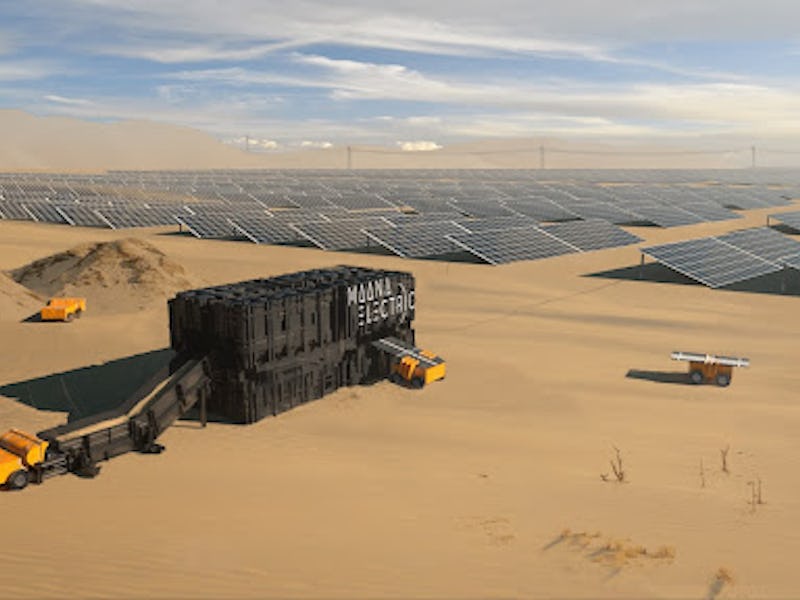These Moon-bound boxes turn sand into solar energy
A small Luxembourgish startup wants to send self-contained solar panel factories to Earth’s deserts as a stepping stone to the Moon.

Sunlight has a couple of advantages over your traditional gas and coal. It’s cheap, it’s powerful, and there’s a lot of it. But there’s a barrier to entry — to harness solar power, you need your own solar panels. This would be true even on the Moon, the next stage of civilization, if billionaires get their way.
But don’t worry, a new company based in Luxembourg will have you watching Netflix in your moon apartment in no time.
But first, let’s solar panel Earth
Maana Electric, and its CEO Joost van Oorschot, has a deceptively simple product pitch. It’s a factory the size of several shipping containers that takes sand and produces solar panels. But before they get to the Moon, they’ll need to send self-contained solar panel factories to Earth’s deserts as a stepping stone.
The company says customers could utilize sand in desert landscapes to save shipping from China, which manufactures most of the world’s solar panels.
It could even produce solar panels for Mars and elsewhere — assuming its planned Earth-based pilot project is successful next year.
Maana is developing a payload for a future Moon mission that could take lunar regolith and convert it into high-purity silicon, producing around one megawatt of solar panels per year. The system could also produce oxygen.
Want to know more about the technology behind Maana panels, how Earth deserts lead to the Moon, and where Elon Musk sees humanity by 2050? Read the full interview with Maana CEO Joost van Oorschot, only in MUSK READS+.
Are Moon and Earth solar panels different?
This box will differ from Earth-based ones as it wouldn’t be so heavy. The box doesn’t need to factor in humidity or other atmospheric conditions on a place like the Moon. The goal is to send the pilot project to the Moon “in the next couple of years or so.”
The firm’s Earth-based projects should lead to the Moon. Van Oorschot says the two boxes share around 60 percent of the same technology.
Does this mean we can expect a panel-covered Moon, one day visible from Earth?
“Initially no … but I think what you're more likely to see is the same as how astronauts … when it's night on Earth, you see all the lights,” he says. “I think you'll see something similar when you're looking at the Moon.”
SpaceX plans to use its upcoming Starship rocket to build a base on the Moon, while NASA also has plans for a long-term Lunar Gateway spaceship to support Moon missions. This could lead to a more significant human presence, one that will need solar panels.
“That's really what we're trying to enable,” he says. “We're trying to power that lunar economy.”
Further out, van Oorschot says the firm could “definitely” do Mars if it can do the Earth and Moon. The big difference will be how the planet is much further from the Sun, which means the panels are less effective.
But as Musk gears up to build a city on Mars as early as 2050, it could find itself in need of a way of producing panels.
“We call ourselves the utility company of the Solar System,” van Oorschot says.
TO READ THE FULL INTERVIEW, SUBSCRIBE TO MUSK READS+.
Here is what you will gain from subscribing to MUSK READS+:
- Three emails per week, enabling fans to go deeper into the week’s news.
- Original interviews and reporting, longform analysis, previews, and recaps of major events, including earnings calls and more.
- Community-focused extras like responses to reader mail, an upcoming event calendar, and notable anniversaries.
- An archive of previous subscriber-only content, so you can easily read back over what you might have missed.
- Promotional deals and offers.
- Supporting original, independent journalism.
MUSK READS+ is a fully independent operation. We are not Elon Musk, nor are we employed by him. Our job is to report the events we find newsworthy, giving you the inside look at the worlds of space rockets, electric cars, clean energy, and more. It means first-hand accounts of a SpaceX rocket launch, Tesla insights from third-party analysts, and more.
If you want to support us in our mission, and receive original interviews and analysis, consider contributing with a subscription.